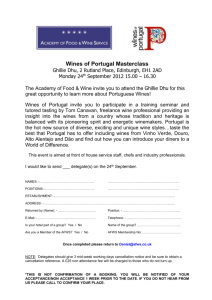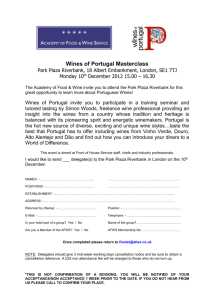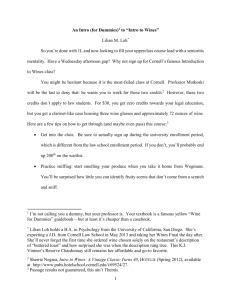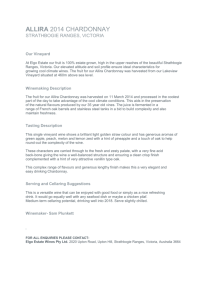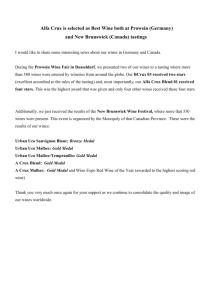Print › WSET Level 4 Diploma Unit 2
advertisement
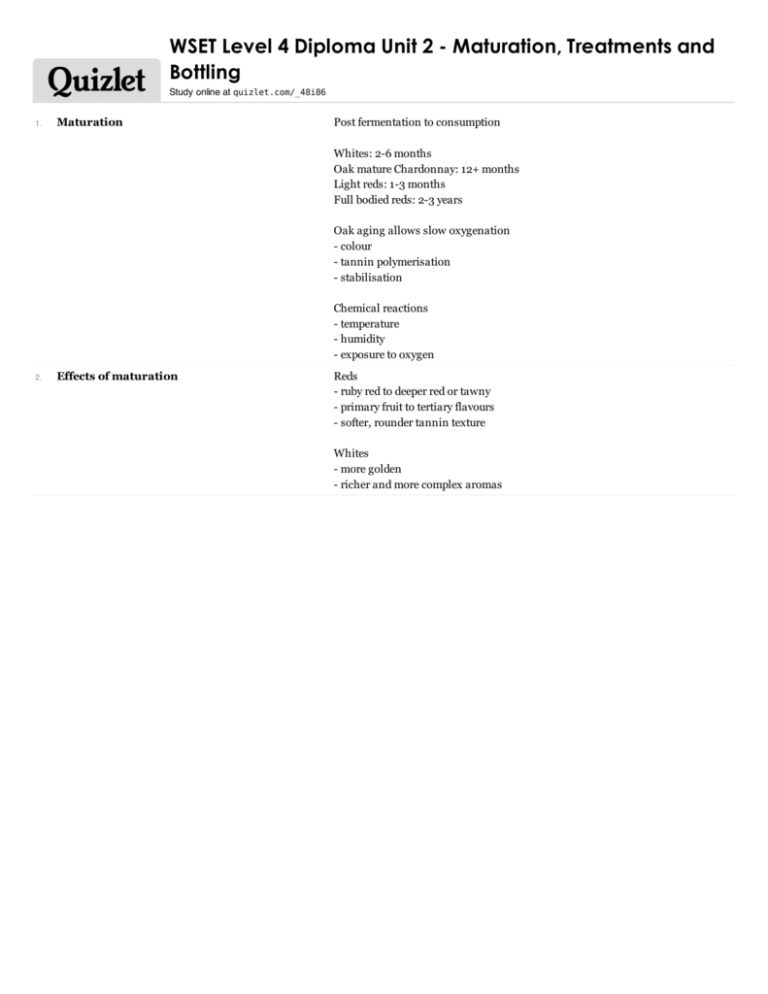
WSET Level 4 Diploma Unit 2 - Maturation, Treatments and Bottling Study online at quizlet.com/_48i86 1. Maturation Post fermentation to consumption Whites: 2-6 months Oak mature Chardonnay: 12+ months Light reds: 1-3 months Full bodied reds: 2-3 years Oak aging allows slow oxygenation - colour - tannin polymerisation - stabilisation Chemical reactions - temperature - humidity - exposure to oxygen 2. Effects of maturation Reds - ruby red to deeper red or tawny - primary fruit to tertiary flavours - softer, rounder tannin texture Whites - more golden - richer and more complex aromas 3. Environmental condistions for maturation Temperature - reds (10 - 20 C), optimum at 15 C - delicate whites and roses (< 10 C) - min fluctuations Humidity - optimum 75 - 85% Oxidation - free SO2 > 20 mg/l - no ullage in vessels - blanket of inert gas (nitrogen, CO2, argon) Micro-oxygenation - two chamber device - porous ceramic material - reduce herbaceous aromas, better oak integration, better control of reductive characters, cost savings on oak Oxidative aging - Oloroso Sherry, tawny Port, Ruthegien liqueur Muscat - nutty, dried fruits and savoury notes Biological aging (flor) - fino sherry, vin jaune (Jura) - yeasty aroma and flavour Lees - MLF, batonnage - softer, richer, more complex wine - off-flavours: H2S, mercaptan odours (cabbage-like) Inert gases - reduce oxidation; prevent spoilage - nitrogen (less soluble, sparge wine to remove oxygen, SO2, red wine) - CO2 (denser than nitrogen, more soluble, flushing, blanket, white wine) - argon (expensive) 4. Oak vessels 225 l barriques (quality red) 228 l Pieces (white) 300 l hogsheads (quality red) 500 l puncheons 20 hl, 50 hl, 100 hl casks in Europe 5. Barrel maturation Clarification and stabilisation Deepen and stablilise colour MLF Complexity of flavours Soften astringency in reds and whites 6. 3 types of oak in winemaking American white oak - winemakers in Spain, Americas, Australia - Oregon, Minnesota, Wisconsin - Auercus alba: low phenols, high aromatics, particularly methy-octalactones (coconut) - Rioja, Australian Shiraz, warm-climate Cabs European white oak - highest quality - expensive - French, Hungarian, Russian, Slavonian, Portuguese Quercus petraea (Quercus sessilliflora) - tight grains, less extractable tannins, aromatic (lactones, volatile phenols - eugenol (cloves), phenol aldehydes - vanillin (oaky and vanilla odours) - Troncais, Allier, Nievre, Vosges (tight-grained wood) Quercus robur - low aromatics, high extractable polyphenols - Limousin (looser-grained, more tannic wood) 7. Barrel-making process Cutting - sawing vs splitting logs - European oak has to be cut or split along oak grain - American oak: less porous, can be sawn, max yield Drying - air vs kiln - less aggressively tannic in air-dried wood - French oak traditionally air-dired (18-36 months) Assembling - use heat to bend the wood - fire vs steam Shaping and toasting - shaped by heat - toasting produces aromatics Heads Finishing - tested for leaks - bung hole, metal or chestnut hoops 8. Toasting barrels Level of toast - heat of the fire - length of time Light --> Medium --> Heavy - the lighter the toast, the more "oaky" or "woody" - the heavier the toast, the more "spicy" and "toasty" 9. Barrel size Gonchihordo - 136 litres Fuder - 1000 litres Stuck - 1200 litres Bordeaux barrique: 225 litres Burgundy pieces - 228 litres The smaller the barrels, the larger the surface area of wood contact to accelerate maturation Barrel age New: woody flavours Replaced after 3rd or 4th use Saved and re-charred for 10 more years Barrel maintenance and hygiene Check for leaks Store wine at 18-24 C (MLF) or 10-18 C (maturing), 75% humidity Cleaning with water under high pressure or steam Storing empty barrels (rinsed, dried, SO2, bunged up) 12. Oak alternatives Oak chips (6.35 mm to 2 cm) Inner staves Barrel inserts Toasted oak powder (legal issues) Stainless steel tanks (aromatic wines, reduction problems) Cement tanks (lined by epoxy resin or glass) Fibre-glass or resin tanks Bottle aging 13. Blending Objectives - style - standardization - balance & complexity - hide faults 10. 11. Between fermentation and bottling Stabilized before bottling The final wine should always be better than its components 14. Components of a blend Wines of different quality --> large volume brand Different vintages for consistency (Champagne, Sherry) Different grapes e.g. Cabernet Sauvignon + Merlot Different barrels or wines subject to different vinification processes (MLF + non-MLF; press + free-run; different yeasts) 15. Examples of blends Champagne (Pinot Noir, Pinot Meunier, Chardonnay) Bordeaux reds (Cabernet Sauvignon, Cabernet Franc, Merlot, Petit Verdot, Malbec) Jacob's Creek Shiraz-Cabernet Sherry (fractional blending, solera system) European table wine (cheap wine from France, Italy, Spain) 16. Clarification Remove "unwanted" suspended particles to make the wine clear Suspended particles - dead yeasts - grape skins, stems, seeds and pulp - bacteria - tartrates - colloids (large organic molecules, polysaccharides, tannins, phenolics, pigmented tannins, heat unstable proteins) Methods - sedimentation and racking - fining - filtration - centrifugation - floatation 17. Sedimentation Speed of sedimentation - density of particles - viscosity of wine - temperature - convection Advantages - gentle, natural process - minimal equipment (hose and pump) Disadvantages - slow - several stages - volume of lees 18. Racking Gross lees are usually racked off after fermentation White in tank: every 2 months Red in barrel: every 3-4 months Check SO2 "Top off" or blanket with inert gases to avoid oxidation CO2 not used coz soluble 19. Centrigugation Very high speeds (10,000 rpm) High flow-rate Expensive Advantages - rapid - removal of dense particles Disadvantages - expensive - noise - oxidation 20. Fining Addition of an agent to remove something Usually added after fermentation and one or two rackings Fining agents - natural or synthetic - electrostatically charged Colloids - -ve (tannins, pectins, dextrans, glucans) - +ve (coloured pigments, proteins) - 2 - 1000 nm (too small for filtration) - cause cloudiness or deposit Effects of fining - remove colloids and stabilize wine - clarify wine - change appearance, aroma and flavour 21. Fining agents Bentonite (-ve) Gelatin (+ve) Casein (+ve) Isinglass (+ve) PVPP (Polyvinylpolypyrrolidone) (+ve) Carbon (charcoal) Silica sol (-ve) Tannin (-ve) Egg albumen (+ve) 22. Bentonite Montmorillonite clay, swells in water Strong -ve charge Reduce enzymes (oxidases), vitamins, amino acids Increase microbial and heat stability of wine Non-selective (reduce flavour) Uses - protein stability in whites and roses - eliminate colloidal colouring matter in young red Commercial bentonites - powder or granule form - sodium bentonite 23. Gelatin Protein extracted from pig skins and animal bones by boiling +ve charge Odourless and colourless Remove off tastes, but reduce the "body" Best used at 16 - 25 C Uses - remove astringency and off-flavours in whites - remove harsh tannins in reds, but also reduce colour Over-fining a white wine - protein-unstable - counter-fined with tannin or silca sol 24. Casein Milk +ve charge Applied in conjunction with tannin Sodium or potassium caseinate Whole milk not permitted in EU Skimmed milk has better clarifying abilities Uses - white fines with excess colour or oxidative taints - reduce iron content of wine 25. Isinglass swim bladder of fish (sturgeon) +ve charge Uses - reduce phenolics - improve colour vibrancy and clarify of whites Disadvantages - fishy nose and palate - can clog filters - expensive - difficult to prepare 26. PVPP Synthetic polymer Strong +ve charge Uses - reduce bitterness and browning in whites - reduce astringency and soften tannins in reds 27. Carbon (charcoal) Burnt animal or plant Used in conjunction with 50 mg/l ascorbic acid to prevent oxidation Uses - remove off-odours and colour - treat final pressings (low doses) 28. Silica sol Colloidal suspension of silicon oxide -ve charge Used in association with gelatin/isinglass Uses - accelerate clarification - produce compact lees to minimize wine loss - remove gelatin - improve filterability of fined wine 29. Tannin -ve charge Blood products not permitted in EU since 1987 Uses - stabilize new wines by precipitating excess proteins - aid fining process (in conjunction with gelatin) 30. Egg albumen whites of chicken's eggs +ve charge Remove less colour or flavour Uses - absorb harshest, "greenest" tannins in reds - premium quality red wines 31. Filtration Flow rate of filter - surface area - pressure - permeability - viscosity - thickness of filter Filterability index (clogging power) of a wine - percentage of solids - size of particles and their nature - MLF wine more difficult to filter 32. Filtration mechanisms Depth filtration (adsorption) Surface filtration 33. Depth filtration (adsorption) unwanted particles trapped in filter medium Earth filtration - diatomaceous earth (DE) or Kieselguh - perlite (musts and cloudy wines) Sheet or pad filtration - pads made of cellulose - papery taste unless rinsed with 1% citric acid Advantages - high solids content - simple to operate - inexpensive Disadvantages - need to control filtration rate - not absolute filtration 34. Surface filtration simple sieving mechanism Membrane with uniformly-sized holes/pores - 0.65 micron (yeast) - 0.45 micron (yeast and bacteria) - 0.2 micron Membrane filters - sterilize wine before bottling Cross-flow filtration - prevent clogging - can filter dirty wines - expensive Ultra-filtration - cross-flow filtration - illegal in EU - can filter out individual components (tannins, sugars, acids) Advantages - absolute Disadvantages - flow rate decrease with volume of liquid - clogging - expensive 35. Reverse osmosis Specialise cross-flow filtration Membrane allows only small molecules Uses - concentrate grape musts - de-alcoholise a finished wine - decrease high levels of acetic acid Advantages - efficient, quiet and automated - total inert gas blanketing and low temperature Disadvantages - expensive 36. Osmotic distillation Specialised membrane filtration process PTFE or Telflon membrane with brine on the other side Uses - high quality grape juice concentration - selective removal of a single volatile, e.g. ethanol 37. Stabilisation Prevent hazes, clouds, bubbles or deposits Stability tests - proteins (bentonite fining) - tartrates (chilling) 38. Wine stability Causes of instability - aeration (e.g. bottling) - light (e.g. shop window displays) - low or high temperatures (e.g. transport or storage) 39. 3 main instability problems Tartrate instability Oxidation and reduction Microbial spoliage Others: proteins, phenolics, copper, iron 40. Tartrate instability - Potassium bitartrate Cold stabilisation prior to bottling - chill wine to -4 (12% abv) to -8 C (fortified) - stored in insulated tanks for up to 8 days - expensive equipment - results not reliable - more dissolved oxygen at low temp Contact process - chill wine to 0 C and add potassium bitartrate crystals (4g/l) - quicker, cheaper, more effective Gum arabic (Acacia) - colloid that prevents tartrate crystal formation - short-lived, about 12 months - 50 - 200 mg/l Metatartaric acid - anti-crystallising properties - short-lived, about 12 months - longer than gum arabic at cooler temp (10 C) - 100 mg/l Mannoproteins - enzymatic hydrolysis of yeast - soluble, no colour, flavour nor taste - long-lasting - 200 to 250 mg/l Ion exchange - not permitted in EU due to health concerns - resin containing sodium ions - sodium bitartrate more soluable - alter aroma and taste Electrodialysis - special selective membranes - passage of potassium, calcium and tartrates ions - high capital cost - low energy costs, reliable result 41. Tartrate instability - Calcium tartrate Calcium carbonate (de-acidification) Calcium bentonite (clarification) Highly soluble, forms crystals only very slowly Stabillised by - metatartaric acid - ion exchange - electrodialysis 42. Oxidation Effects - change colour (brown and dull) - change aromas and flavours (sherry-like) - increase bitterness Factors - polyphenol oxidase & lacasse ennzymes (grey rot) - yeast & acetic acid bacteria - phenolics - dissolved oxygen - pH - SO2 - temperature - catalysts (e.g. copper ions) Stabilisation - pasteurisation (laccase) - storage at low temperature, SO2 (browning) 43. Reduction H2S (rotten eggs), mercaptans, organic sulphides, thiols (garlic or onion) Removal - aeration - copper sulphate; silver chloride 44. Microbial spoliage Microorganisms - lactic acid bacteria - acetic acid bacteria - yeast - moulds Factors - pH (high) - alcohol (< 15%) - temperature (20-35 C) - SO2 (free 20 mg/l) - residual sugar - nutrients - air (for acetic bacteria) - winery hygiene 45. Lactic acid bacteria useful for MLF not for light, fruity whites Wines with low acidity - breakdown of tartaric acid - slimy and "ropy" texture Prevention - SO2 (20 mg/l) - clarification - goog winery hygiene 46. Acetic acid bacteria Converts alcohol to acetic acid (vinegar) Form ethyl acetate (ethyl ethanoate) - acetone (nail polish remover) Prevention - minimize air - SO2 (20 mg/l) - good winery hygiene 47. Spoilage yeasts Sterile filtration at bottling Surface "film" spoilage yeasts (Candida) - flor on surface of wine that is in contact with air - oxidise ethanol to produce acetaldehyde (ethanal) - yeasty taint - prevention - barrels fully "topped up" or blanketed with inert gas - SO2 (20 mg/l) - good winery hygiene Brettanomyces - 4-ethyl-phenol and 4-ethylguaiacol - brett taint (farmyard and sticking-plaster flavours) - high pH Syrah and Cabernet Sauvignon - prevention - sterile filtration - DMDC (dimethy dicarbonate) - SO2 Re- fermentation - cloudiness and gasiness - prevention - sterile filtration - sorbic acid (potassium sorbate; 100 - 200 mg/l; strange, rancid flavour; metabolised by lactic acid bacteria to create an aromatic compound that smells of geraniums) 48. Protein instability Hot or cold temperature Whites: haze, cloudiness or deposit Reds: deposit of pigmented tannins and protein Removal by bentonite fining 49. 50. Phenolic instability Fined with albumen (egg whites) or gelatin Excess copper Max in EU - 1 mg/l Causes - contact with copper, tin or bronze equipment - use of copper sulphate to eliminate H2S and mercaptans - use of copper sulphate to combat powdery mildew Gas chromatography - direct sunlight for 7 days Effects - copper casse in whites (reddish-brown haze and deposit) Prevention - bentonite fining - gum arabic - potassium ferrocyanide (blue fining) - highly toxic 51. Excess iron Max in EU - 10 mg/l Causes - soil with high levels of iron - mild steel or cast iron containers or crusher rollers Gas chromatography - excess oxygen in cool, dark place for 48 hours Effects - ferric casse in whites (haze and white deposit) - blue-black deposit in reds Prevention - citric acid (1 g/l) - gum arabic - ascorbic acid - potassium ferrocyanide (whites) and calcium phytate (reds) 52. Quality control Series of anlyses and tests - compliance with regulations - stability - faults and other contaminants Carried out at - bulk storage of wine - transportation - bottling 53. QC - bulk storage Vessels topped off or blanketed with inert gas Stable cool temperature (< 15 C) No exposure to sunlight SO2 (25-30 mg/l for dry reds; 35 mg/l for dry whites) 54. QC - transportation Cool storage temperatures (avoid shipping in summer; refrigerated containers and lined containers) SO2 Inert gas in headspace of vessels No exposure to sunlight Sweet wines imported in bulk into the EU cannot be shipped as dry wines and sweetened at bottling. 55. QC - bottling Prevent - oxygen - microbial contamination - bottle dirt, cork dust, grease, insects HACCP (Hazard Analysis and Critical Control Point) - food safety procedure to reduce hazards to acceptable - compulsory in EU - hazards (physical, chemical, microbiological) - Remove or monitor CCPs (Critical Control Points) - preventative action plan - minimize likelihood of something serious - identify most likely reasons for errors CCPs in bottling - check bottles - control fill - no contamination - check corks ISO 9001 - quality managment system - set of procedure - records - review 56. Bottling operation Pre-bottling analysis 57. Pre-bottling analysis Equipment - gas chromatograph - atomic absorption spectrometer 58. SO2 - titration with iodine - alkaline to release bound SO2 before titration - aspiration method (EU) 59. Volatile acidity (VA) - acetic acid - glass still to distill VA - titration with sodium hydroxide - enzymatic assay - HPLC (high performance liquid chromatography) 60. Titratable acidity (total acidity) - de-gassed sample to an end point of pH 7.0 - sodium hydroxide - g/l tartaric acid (sulphuric acid in France x 5/3) - table wines (> 4.5 g/l), avg 5-7 g/l, high 8 g/l 61. Malic acid and lactic acid - paper chromatographic procedure - HPLC 62. Other acids Sorbic acid - colorimetric procedure - wines for Japan Ascorbic acid - simple titration or HPLC Metatartaric acid - HPLC Citric acid - HPLC 63. Alcohol - distillation and hydrometrics - ebulliometer 64. Residual sugar - Fehlings titration with copper salts - enzymatic assay or HPLC 65. pH - pH meter - most wines: 2.8 to 4.0 - cool-climate whites: 3.0 to 3.2 - hot-climate reds: 3.4 to 3.6 - softer, ripe reds: > 3.7 66. CO2 - measured enzymatically or by titration - 600-1000 mg/l is common 67. Total dry extract (TDE) - measures all things non-volatile - detection of fraudulent practices - dry whites: 16 - 20 g/l 68. Stability analysis Tartrate stability (cold stability) - -4 C liquid bath for 72 hours Protein stability (heat stability) - heated to 90 C for 6 hours 69. Trace metals Metal analysis - copper, iron, potassium, calcium, sodium - flame atomic absorption spectrophotometer Anion analysis - choride and sulphate - HPLC 70. Dissolved oxygen (DO) - oxygen meter - < 0.3 mg/l to minimize oxidation - "sparged" with nitrogen or CO2 71. Microbial populations Yeast, bacteria - petri dish - microscope 72. Taint analysis 3 main halo-anisoles (musty odours) - TCA (2,4,6-tricholoranisole) - TeCA (2,3,4,6-tetrachloroanisole) - TBA (2,4,6-tribromonoanisole) Causes - cellar atmosphere - tanks, barrels, oak chips, filter pads, closures, bentonite GC-MS (gas chromatography-mass spectrometry) 73. Bottling equipment Membrane filter (0.45 micron for sterile filtration) Bottle rinser (filtered water and acidified SO2 solution) Filler (siphoning, gravity, differential pressure) Corker (capper) Labeller 74. Bottling options Traditional bottling (dry wines) Aseptic bottling - filtration (e.g. cold sterile filtration) - heat treatment (e.g. flash pasteurisation, tunnel pasterurisation, thermotic bottling) 75. Cold "sterile" (aseptic) filtration Sterilise bottling line equipment - hot most steam at 115 C - hot water for 20 minutes Wine to pass through sterile membrane into bottle - aromatic whites with residual sugar (no MLF) - fruity red wines Advantages - simple, cheap, reliable - no risk of re-contaminiation or re-fermentation in bottle Disadvantages - training of staff - costs (hot water, membrane filters) 76. Bottling using heat Wines of moderate quality Flash pasteurisation - high temp for short period of time - 80 - 90 C for few second, then rapid cooling - pros: simple equipment, min damage to wine - cons: re-infection, operator training - low end reds and whites Tunnel pasteurisation - high temp for medium length of time - bottles pass through heated tunnel, sprayed by hot water - over 80 C for 15 minutes - cold water sprays - pros: no need for sterile bottling - cons: expensive equipment, heat damage - low end sparklings Thermotic bottling - medium temp for a long time - heat to > 55 C - fill bottle with warm wine, sealed and cooled - pros: no need for sterile bottling; advance maturity of young reds - cons: filling levels - bulk, low end wines 77. Packaging Contain the wine (transport, store, serve) Protect wine against contamination and degradation Provide information Appeal to consumers 78. Containers Glass bottles - inert, impermeable, cheap to produce - coloured to reduce UV - shrink-wrapped while still hot - 3 shapes (Bordeaux, Burgundy, German/Alsace Flute) Bag-in-box - polyester film coated with aluminium foil, between two layers of high density polyethylene - 2, 3, 5, 10, 20 litres - prone to oxidation, high SO2 dosage - tartrates can clog tap - not for wines with high level CO2 - not for wines requiring bottle maturation - limited shelf life (12 months) Plastic containers - little protection against oxygen transfer - short shelf life - negative image - PVC (no protection against light, oxygen): few week life - PET (ligh, robust, recyclable), short life Other composite cartons - paper laminate, foodgrade polyethylene, aluminium foil - Tetra pak (1 and 2 litres) - low cost "sterile" packaging - image problems Aluminium cans - plastic liner - light, fully recyclable 79. Closures Reliable seal Inert Easy to remove 80. Closures for glass bottles Natural cork - Quercus suber - elastic, resilient, compressible, impermeable to liquids - 44 x 24 - cock taint (TCA, TBA, TeCA) - gas chromatography with mass spectrometry - solid phase micor-extraction - Steam distillation - Oeneo: supercritical CO2 Technical cork-based closures - Agglomerated cork stopper - cork bits stuck together by resin-based glue - Diam and Neutrocork - Colmated cork stopper - natural cock covered with cork dust and latex - types of technical corks - 1 + 1/2 + 2 (cork discs at either ends) e.g. TwinTop by Amorin - DIAM by Oeneo (agglomerated, supercritical CO2) Synthetic closures - foodgrade plastics - ethylene vinyl acetate, silicone oil coating - inexpensive - 5 yrs shelf life - negative consumer perception & non-recyclabiilty - Nomacorc, Supremecorq, Neocork, Intega Screwcaps - aluminium alloy cap - polyethylene / tin liner - cheaper, easy to remove, inert, long life, tight seal - costs of bottling equipment, special bottles, reduction Crown caps - Champagne aging - cheap, easy to apply, tight seal, long life - consumer preception Vinolok - Germany - glass/plastic bottles - no TCA, easy to open, no odour, stylish - questionable for long-term storage

